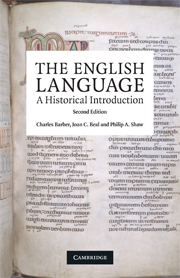Book contents
- Frontmatter
- Contents
- List of figures
- Preface to the second edition
- Preface to the first edition
- Map showing the counties of England
- 1 What is language?
- 2 The flux of language
- 3 The Indo-European languages
- 4 The Germanic languages
- 5 Old English
- 6 Norsemen and Normans
- 7 Middle English
- 8 Early Modern English
- 9 Late Modern English
- 10 English as a world language
- 11 English today and tomorrow
- Notes and suggestions for further reading
- Bibliography
- Index
3 - The Indo-European languages
- Frontmatter
- Contents
- List of figures
- Preface to the second edition
- Preface to the first edition
- Map showing the counties of England
- 1 What is language?
- 2 The flux of language
- 3 The Indo-European languages
- 4 The Germanic languages
- 5 Old English
- 6 Norsemen and Normans
- 7 Middle English
- 8 Early Modern English
- 9 Late Modern English
- 10 English as a world language
- 11 English today and tomorrow
- Notes and suggestions for further reading
- Bibliography
- Index
Summary
We have talked about related languages and language families. What languages is English related to? If you know any European languages, you may well have been struck by resemblances between them and English. For example, German Vater, singen, leben and Stein resemble their English translations father, sing, live and stone. Resemblances alone do not prove relationship, however: the resemblances must be systematic. Consider then table 3.1, which shows a number of words of similar (but not necessarily identical) meaning in modern English, German and Swedish.
The thing to notice here is not just that the words look alike, but that there are regular correspondences: words with Southern British English /ǝʊ/ have German /ɑɪ/ (spelt <ei>) and Swedish /eː/ (spelt <e>). Such correspondences arise when related languages are produced by divergent development, because, as we have seen, the changes in pronunciation in any one language or dialect follow regular sound laws.
There are indeed certain anomalies in the table. German Bein does not mean ‘bone’ but ‘leg’; the Swedish word ben, however, means both ‘bone’ and ‘leg’, and the same was once true of the German word. German Reif means ‘ring, hoop’, but formerly it also meant ‘rope’. The English word one apparently does not fit the pattern, for it has the wrong pronunciation; if we go back a thousand years, however, we find that one is descended from an Old English word ān (pronounced with a long [ɑː], as in father), and the other words in the table also have this long ā in Old English: stān, bān, āc, hām, rāp, gāt.
- Type
- Chapter
- Information
- The English LanguageA Historical Introduction, pp. 57 - 84Publisher: Cambridge University PressPrint publication year: 2009

